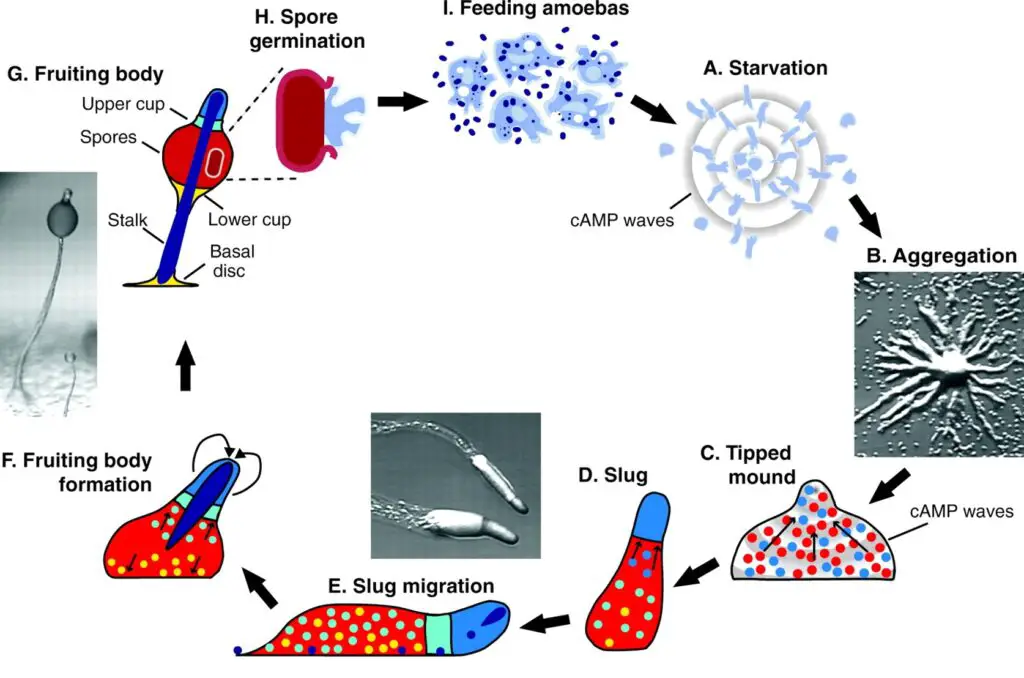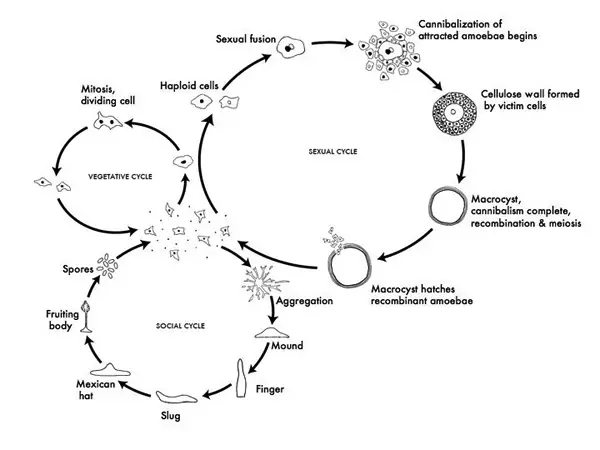The Complete Life Cycle of Dictyostelium: (Explained in Detail)
Introduction to Dictyostelium
Dictyostelium is a member of the Amoebozoa, a taxon that is basal to the Metazoa branch. They are commonly referred to as Slime moulds.
They are called Slime moulds because they are unrelated eukaryotic organisms that can live freely as single cells, but also can aggregate together to form multicellular reproductive structures whenever the need arises.
They are soil-dwelling Amoeba belonging to the phylum Amoebozoa, and infraphylum Mycetozoa.
Scientific classification of Dictyostelium
- Phylum: Amoebozoa
- Infraphylum: Mycetozoa
- Class: Dictyostelia
- Order: Dictyosteliida
- Family: Dictyosteliidae
- Genus: Dictyostelium
It is a unicellular eukaryote that can from a collection of unicellular amoebae and then into a fruiting body forming a multicellular slug during its life cycle.
D. discoideum habitats moist underground soil full of living and dead organic matter. Its primary diet consists of bacteria, such as Escherichia coli, found in the soil and decaying organic matter.
Another very noteworthy fact about D. discoideum is that it can engulf photosynthetic bacteria within its cell to become photosynthetic itself.
These amoebae can engulf a bacterium and keep it within its cell alive and will eventually utilize the bacterial genes for the purpose of photosynthesis.
Uninucleate amoebae of D. discoideum consumes bacteria found in its natural habitat, which includes deciduous forest soil and decaying leaves.
Dictyostelium discoideum can engulf and keep the bacteria within the cell. And, as agriculture seems to need bacterial survival and it is possible as various bacteria can live and replicate inside D. discoideum, making farming a lot easier.
Dictyostelium discoideum also stays in association with Burkholderia bacteria. This helps in the rapid spread of Burkholderia along with the amoeba in the agricultural field and this bacteria acts as biopesticide for protecting crops.
Life cycle and reproduction of Dictyostelium discoideum
Dictyostelium discoideum can show both asexual reproduction and sexual reproduction.
In general, D. discoideum generally reproduces asexually with the formation of spores, but under certain suitable conditions they can reproduce sexually resulting in the formation of a diploid zygote.
Let’s know about each of the two types of reproduction in the Life cycle of Dictyostelium discoideum :
- By Asexaul Reproduction: Results in the formation of spores
- By Sexual Reproduction: Results in the formation of diploid (2n) Zygote

By Asexual Reproduction
1. The asexual life cycle begins with the release of spores from a mature fruiting body. A single mature fruiting body can contain as many as 100,000 myxamoebae cells of Dictyostelium discoideum.
2. Myxamoebae are haploid and as soon as they hatch from the spores under warm and moist conditions they enter their vegetative stage.
3. During their vegetative stage, the myxamoebae divide by mitosis as they feed on bacteria. The myxamoebae Dictyostelium exist as undifferentiated and single cells that are well-capable of dividing indefinitely by mitosis every 4 to 10 hours.
4. The secretion of Folic acid from bacteria that they will feed on attracts all the surrounding myxamoebae together into a central place. They remain in a central place when the supply of bacteria is proper and adequate.
5. As soon as the supply of bacteria is depleted, the myxamoebae enter the aggregation stage. This is due to the starvation of myxamoebae because of the lack of availability of food.
6. During this aggregation stage, starvation initiates the Glycoproteins and Adenylyl cyclase machinery. The Glycoproteins allow for cell-cell adhesion, and Adenylyl cyclase creates cyclic AMP.
7. Then aggregation (cluster) of myxamoebae occurs when the Cyclic AMP that is secreted by the myxamoebae starts to attract neighboring cells to a central location. And as they move toward the central location, they bump into each other and stick together due to the presence of Glycoprotein adhesion molecules.
8. This will result in the formation of loose aggregate and then a tight aggregate respectively. This will be viewed as an elongated mound of cells that will gradually lie over the ground.
9. The amoebae in the tight aggregate will work together as a motile pseudoplasmodium, which is also known as a slug. The slug is about 2–4 mm long and is majorly composed of up to 100,000 cells. It is capable of movement by producing a cellulose sheath in its anterior cells through which the slug moves.
10. The slug can move in a forward-direction by getting stimulated by the factors of light, heat, and humidity.
11. Sooner or later, the slug becomes differentiated into prestalk cells in the anterior end, prespore cells in the posterior end, and Anterior-like cells in the posterior region of the slug, respectively.
12. After the slug gets a suitable spot and environment, it will soon turn into a fruiting body. The prestalk cells on the anterior end of the slug will form the stalk of the fruiting body, the prespore cells on the posterior end of the slug will form the spores of the fruiting body, and the anterior-like cells will form the very bottom of the fruiting body and the caps of the spores.
13. After the slug settles into one spot, the posterior end spreads out with the anterior end raised in the air, forming what is called the “Mexican hat”, and soon after this, the culmination stage begins.
14. During the culmination stage, the prestalk cells, and prespore cells switch positions to form the mature fruiting body. This fruiting body is 1–2 mm tall and is now able to start the entire cycle over and over again by releasing the mature spores that will again become myxamoebae.

By Sexual Reproduction
Heterothallic or homothallic type of sexual development has been seen in D. discoideum if certain conditions are met.
Heterothallic species have sexes that reside in different individuals. On the other hand, Homothallic species have sexes that reside in the same individual.
There are 3 different mating types in Dictyostelium discoideum. These are Dictyostelium discoideum Type-I, Dictyostelium discoideum Type-II, and Dictyostelium discoideum Type-III.
And it is also very important to note that each of the type can only mate with the two different types and not with its own.
Recent genetical studies have identified the sex locus that specifies these three mating types.
- Dictyostelium discoideum Type-I strains are specified by the gene called Mat A
- Dictyostelium discoideum Type-II strains have three different genes: Mat B (homologous to Mat A), Mat C, and Mat D
- Dictyostelium discoideum Type-III strains have Mat S and Mat T genes (which are homologous to Mat C and Mat D)
When the various individuals of Dictyostelium discoideum are incubated with their bacterial food supply, heterothallic or homothallic sexual development can occur, resulting in the formation of a diploid zygote.
Homothallic or Heterothallic sexual mating occurs only in a dark and wet environment when two different amoebae of different mating types come and fuse together forming an aggregate. This will result in a diploid giant cell.
The giant cell will then releases cAMP to attract other cells. And then, this giant cell will engulf and feed on the other cells to form an aggregate with a thick cellulose wall to protect it. This is known as a macrocyst.
Inside the macrocyst, the giant cell divides first through meiosis, then through mitosis to produce many haploid amoebae that will be released to feed as normal amoebae D. discoideum.
Final Words
Thus, it can be concluded that at the majority instances of the life cycle of Dictyostelium the haploid amoeba always undergoes the vegetative cycle (asexual reproduction) by feeding on the bacteria in the soil, and periodically dividing mitotically.
During the starvation timing, when the availability of food (bacteria) is very scarce, the haploid amoeba Dictyostelium chooses either to reproduce by Sexually or Asexually.
Under the social asexual cycle, amoebae aggregate and form a motile slug, which ultimately forms a fruiting body.
On the other case, when seen under the sexual cycle, amoebae aggregate and two cells of opposite mating types fuse together to form a giant cell that will consume the other nearby attracted cells.
This giant cell with the consumed other cells is the diploid (2n) cell that is often termed as macrocyst. This will eventually undergo recombination and meiosis respectively to form numerous haploid (n) Dictyostelium amoebae.
That’s how the cycle begins again and again.
